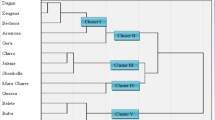Summary
Fifty five potato varieties were compared withMajestic for the resistance of their tuber tissues to infection byPhytophthora infestans (Mont.) de Bary in three kinds of test using 1. halved tubers; 2. tuber slices and 3. whole tubers.
Tissue resistance was better indicated by the extent surface mycelium developed after the fungus had grown through a slice of standard thickness (Test 2) than by the density of surface mycelium on the inoculated surface (Test 1) or by the area of necrotic tissue (Test 1 and 3).
Most varieties that suffer few tuber infections when grown as field crops were rated as resistant by these tests. Tissue resistance as assessed by these simple laboratory tests, which require only few replicates, could be used to select tuber-resistant varieties.
Zusammenfassung
In dieser Arbeit werden Untersuchungen beschrieben, die 1959 und 1960 mit Knollen von 55 Sorten angestellt wurden. Es handelte sich darum, die Fähigkeit derP. infestans die Knollengewebe zu befallen im Vergleich zu dieser Fähigkeit bei der SorteMajestic, deren Knollen sehr resistent sind, zu ermitteln.
Es wurden drei Untersuchungsmethoden angewendet: 1. halbierte Knollen, 2. Knollenscheiben und 3. ganze Knollen sowie rasche Bewertungsmethoden nach Punktzahlen, in der Regel von 1 (keine Reaktion) bis 4 (maximale Reaktion). Die Ergebnisse sind in dentabellen 1 und 2 dargestellt, Sorten mit gleicher oder grösserer Knollenresistenz im Feld alsMajestic sind in Fettdruck angegeben.
Um den Nutzen einer einzelnen Untersuchungsmethode (tabelle 3) zu bewerten, wurden zwei Kriterien betrachtet: 1. die Anzahl der feldresistenten Sorten, die durch den Test nicht entdeckt wurden (die Bewertungszahlen fürMajestic fanden beim Vergleich als Standard Verwendung), 2. die Anzahl der im Feld anfälligen Sorten, die anhand des Labortests als resistent beurteilt wurden.
Der Knollenscheibentest vermittelte die eindeutigsten Angaben bezüglich Resistenz gegenüber Knolleninfektionen unter Feldbedingungen (tabelle 5) und wird für den Züchter als nützlich betrachtet.
Vergleiche zwischen Sorten (nach Impfung der ganzen Knollen) basierten auf der Form des befallenen Gewebes (Abbildung). Obwohl der Test selbst von beschränktem Wert war, wurden die Unterschiede in der Resistenz der verschiedenen Knollenteile deutlich aufgezeigt.
Bei einigen Sorten z.B.Record, schien der Gefässbündelring als eine Sperre gegenüber dem Pilz zu wirken. Wurde die Sperre durchbrochen, so wurde das innere Markgewebe umfassend befallen (Tabelle 4).
Résumé
Le travail décrit les tests exécutés en 1959 et en 1960 sur des tubercules de 55 variétés; la capacité duP. infestans d'envahir les tissus du tubercule se détermine par comparaison avecMajestic, dont les tubercules sont résistants.
Les tests sont de trois sortes et portent sur 1. des demi-tubercules, 2. des tranches de tubercules et 3. des tubercules entiers. Les évaluations sont rapidement cotées suivant l'échelle 1 (aucune réaction) à 4 (réaction maximale). Les résultats sont détaillés dans lestableaux 1 et 2 dans lesquels les variétés de résistance du tubercule au champ égale ou plus grande queMajestic sont imprimées en gros caractères.
La valeur d'un test quelconque (tableau 3) est basée sur les deux critères suivants: 1. le nombre de variétés qui sont résistantes au champ et dont la résistance n'est pas décelée par le test, les cotes deMajestic servant de comparaison, et 2. le nombre de variétés susceptibles au champ que le test de laboratoire considère comme résistantes. Le test sur tranche de tubercule donne l'indication la plus claire de la résistance du tubercule dans les conditions au champ (tableau 5) et est considéré utile à l'améliorateur.
Les comparaisons variétales à partir d'inoculation de tubercules entiers sont basées sur la forme des tissus pourris (fig. 1) et bien que le test luimême soit de valeur limitéc, des différences de résistance de diverses régions du tissu du tubercule se révèlent clairement.
Dans quelques variétés, par ex.Record, la zone vasculaire se révèle agir comme une barrière et quand la barrière est rompue les tissue médullaires internes pourrissent fortement (tableau 4).
Similar content being viewed by others
References
Bonde, R., F. J. Stevenson andC. F. Clark (1940): Resistance of certain potato varieties and seedling progenies to late blight in the tubers.Phytopathology.30, 733–748.
Davila, E. (1964): Late blight infection of potato tubers.Amer. Potato J. 41, 103–112.
Hogen Esch, J. A., andH. Zingstra (1957): Geniteurslijst voor Aardappelrassen. Commissie ter bevordering van het onderzoek van nieuwe aardappelrassen, Wageningen. 147 pp.
Jones, L. R., N. J. Giddings andB. F. Lutman (1912): Investigations of the potato fungusPhytophthora infestans. Bull. Vermont Agric. Exp. Sta. No. 168, 100 pp.
Kehoe, H. W. (1962–1964): Potato Variety Trials. In:Res. Rep. (for 1961–1963), Pl. Sci. Crop Husb. Div., The Agric. Inst. Dublin.
Lapwood, D. H. (1961): Haulm and tuber resistance toPhytophthora infestans. In:Rep. Rothamst. Exp. Sta. 1960. 123–124.
— andR. K. McKee (1961): Reaction of tubers of R-gene potato clones to inoculation with specialized races ofPhytophthora infestans.Eur. Potato J. 4, 3–13.
Mélard, V. (1961): L'amélioration de la résistance auPhytophthora de la pomme de terre en Belgique.Eur. Potato J. 4, 40–51.
Mooi, J. C. (1963): A laboratory method for testing tubers of potato varieties for ‘field resistance’ to late blight. In:Proc. 2nd trienn. Conf. Eur. Ass. Potato Res. Pisa, 1963, 195.
Muller, K. O., J. C. Cullen andM. Kostrowicka (1955): Testing ‘true resistance’ of the potato to blightPhytophthora infestans.J. nat. Inst. agric. Bot. 7, 341–364.
National Institute of Agricultural Botany, Cambridge (1964): Varieties of Potatoes.Fmrs. Leafl. natn. Inst. agric. Bot. No. 3, 8 pp.
Weihing, J. L. andR. B. O'Keefe (1962): Epidemiological potentials of potato varieties in relation to late blight.Phytopathology.52, 1268–1273.
Author information
Authors and Affiliations
Rights and permissions
About this article
Cite this article
Lapwood, D.H. Laboratory assessments of the susceptibility of potato-tuber tissue to blight (Phytophthora infestans). Europ. Potato J. 8, 215–229 (1965). https://doi.org/10.1007/BF02364290
Accepted:
Issue Date:
DOI: https://doi.org/10.1007/BF02364290




